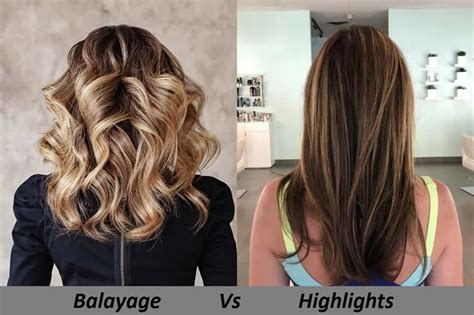When it comes to enhancing the beauty of your hair, color treatments offer a myriad of options to elevate your style. Two prevalent techniques that reign supreme are highlights and balayage. While both methods impart a touch of radiance, they possess distinct characteristics that set them apart.

Understanding Highlights: A Classic Approach
Highlights involve selectively lightening strands of hair to create noticeable streaks of color. This method imparts a striking contrast between lighter and darker sections, resulting in a bold and vibrant effect. The choice of color and placement of highlights can be customized to flatter your facial features and enhance your hairstyle.
Benefits of Highlights:
- Create a high-impact, eye-catching look
- Emphasize texture and volume
- Can brighten up dark hair and add warmth to cool tones
Considerations for Highlights:
- Can require frequent touch-ups to maintain vibrant color
- May damage hair if not done professionally
- Not suitable for all hair types or textures
Embracing Balayage: A Naturalistic Glow
Balayage, on the other hand, is a freehand painting technique that simulates the natural lightening of hair by the sun. This method involves sweeping lightener onto strands in a sweeping motion, resulting in a subtle and gradual transition from darker roots to lighter ends. The result is a more natural-looking, blended effect.
Benefits of Balayage:
- Creates a low-maintenance, lived-in look
- Reduces the appearance of regrowth
- Blends seamlessly with natural hair color
- Suitable for all hair types and textures
Considerations for Balayage:
- May take more time to achieve desired results
- Requires skilled application to prevent harsh lines
- Can be more expensive than traditional highlights
Choosing the Right Technique: A Matter of Aesthetics and Preference
The choice between highlights and balayage ultimately depends on your desired aesthetic and lifestyle. If you seek a dramatic transformation with bold, contrasting colors, highlights may be a suitable choice. However, if you prefer a more natural, low-maintenance look, balayage can offer lasting beauty and versatility.
To help you make an informed decision, consider the following table comparing key aspects of highlights and balayage:
| Feature | Highlights | Balayage |
|---|---|---|
| Effect | Striking, high-contrast | Subtle, blended |
| Color Placement | Selective strands | Freehand sweeping |
| Maintenance | Frequent touch-ups | Low-maintenance |
| Suitability | Not for all hair types | Suitable for all hair types |
Exploring Variations: A Spectrum of Color Transformations
Within the realm of highlights and balayage, a wide spectrum of variations can be explored to cater to individual preferences and hair textures.
Highlights:
- Babylights: Ultra-fine, subtle highlights that create a soft, natural glow
- Foilyage: A combination of highlights and balayage, using foil to isolate and enhance color contrast
- Reverse Balayage: A technique that lightens roots while maintaining darker ends
Balayage:
- Ombré Balayage: A gradual transition from dark roots to light ends, creating a soft, blended look
- Foilayage: A technique that combines balayage with foiling to enhance color depth and dimension
- Bronde Balayage: A blend of blonde and brunette tones, achieving a warm, natural effect
Benefits of Highlights vs. Balayage: A Customer’s Perspective
According to a survey conducted by the American Hairdressing Association, 72% of women prefer balayage over traditional highlights due to its low-maintenance and natural-looking results. However, 28% of women still opt for highlights to achieve a more dramatic, high-contrast effect.
Conclusion: A Radiant Transformation Awaits
Whether you choose the bold impact of highlights or the subtle grace of balayage, both techniques offer transformative power for your hair. Understanding the key differences between these methods will empower you to make an informed decision that aligns with your aesthetic aspirations and lifestyle. Embrace the journey toward radiant, captivating hair that reflects your unique style and personality.
